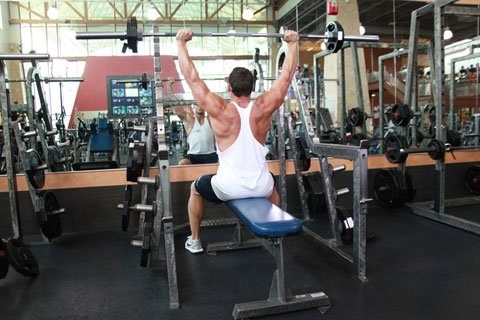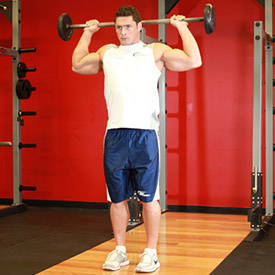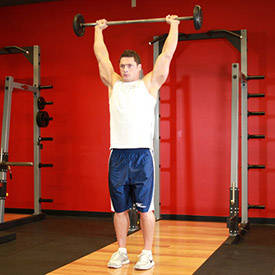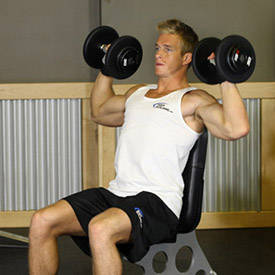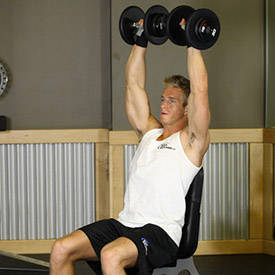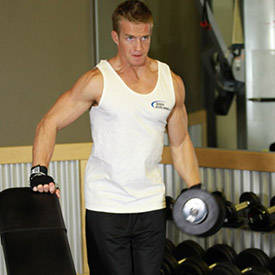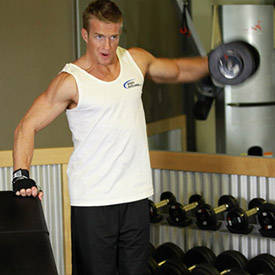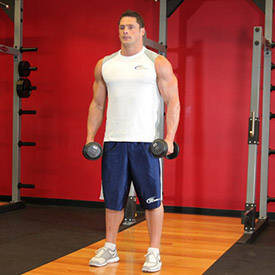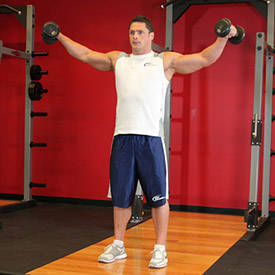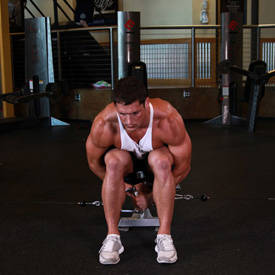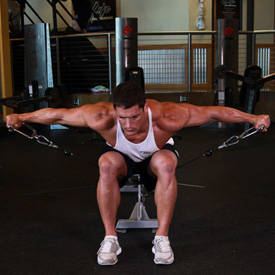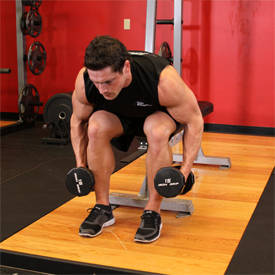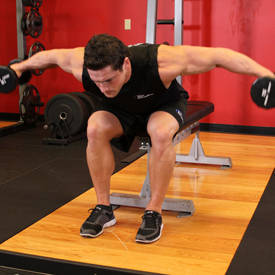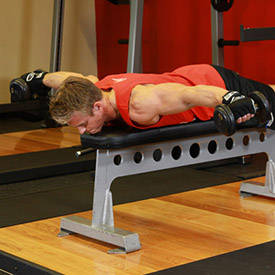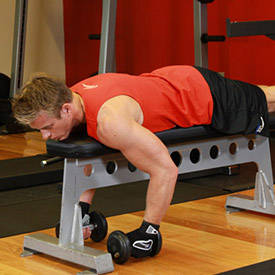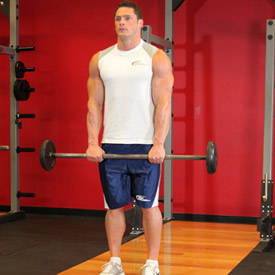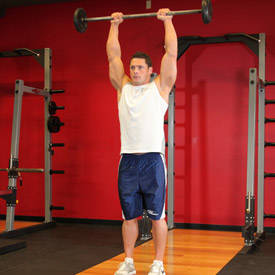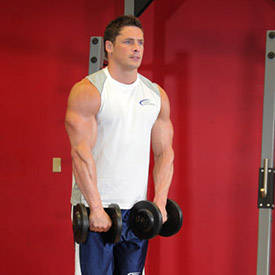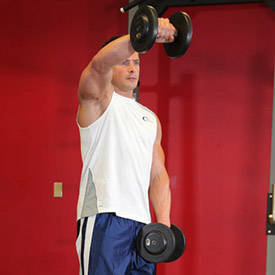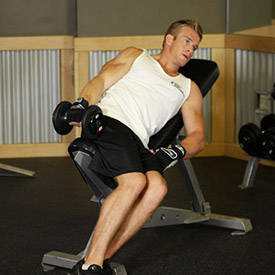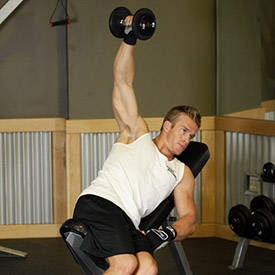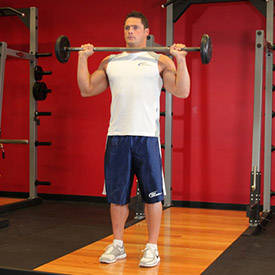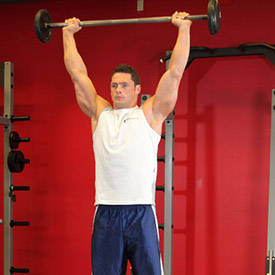The shoulders are the key element in building an impressive physique. Every element holds its own in the whole that forms the amazing bodies that bodybuilding produces and no true bodybuilder will tell you that one body-part can make up for the lack of size in another because symmetry is all-important at the natural level. But the shoulders make the man. No body-part exudes the image of strength and size as the deltoids do. Whether you are fat or thin, wearing clothes like you were going to trek Antarctica or oiled up for a show, shoulders that stick out give an immense impression.
Wide shoulders are the first element of an X-frame that makes for the superior view in a front relax pose. Wide shoulders cover possible flaws of the focal point of the waist and overshadow the overall upper body. Everybody wants a big chest and big arms, but without the shoulder width to back it up they just look like absolute idiots. No one with underdeveloped shoulders has a hope of achieving any bodybuilding goals. Be it picking up babes at the beach or flexing onstage at the Olympia.
I have immense respect for all bodybuilders that owned the coveted crown that is the Olympia, but even more for their runner-ups who were often ignored. Most, like Shawn Ray, the dubious Flex Wheeler and the magnificent Kevin Levrone (my favorite) managed to overshadow the sheer size of the Olympia champs with magnificent shoulder development and great abs. Even the unsymmetrical Markus Ruhl exhibits enormous qualities because of his shoulder development, so much that he can wipe out an entire line-up with a single most-muscular pose. In short, shoulders are the basis of a great body...

Workload And Complete Development
The greatest mistake you can make when training the shoulders is not giving them enough work. They are very strong, because the actions of chest, arms, traps, neck and part of the back hinge on the proper functioning of the shoulders. So if they get all this work in a day and don't even fatigue, what makes you think that you can make them grow with 6 or 7 sets? Moreover, you can't develop an even symmetrical shoulder with that small amount of work.
The shoulders are made up of three separate heads. To give them their full potential and striation you need to get an amount of isolative work for each head. The problem is that the deltoids are a very synergistic muscle-group and if you don't stimulate enough fiber in the overall muscle they won't grow, so hitting them with only isolative work isn't an option either. So, this far you are up to four exercises. Generally that is enough, but at 2-4 exercises that get you up to 8 sets at least and usually about 12 on average.
In contest preparation you'll need to get some separation between the shoulders, the arms and the traps, and that can get you up to 5 or 6 exercises easily. The good news is that you only need one compound exercise. Once the shoulder has been stimulated and you get a good pump going, generally the isolative exercises will take care of the rest from there on out. The trick is to get enough from your compound exercise. There is no reason why you would shy away from the workload. If there is any muscle that you would naturally give its own training day, it would be the shoulders because they don't combine well with any other muscle-group anyway. Only the traps can, and should, be added to shoulder day.
In some muscles you can adapt the training from week to week to get a full development without having to do a lot of sets every week, but because of the synergistic nature of the muscle-group, I don't advise skipping any areas. If one of the heads is really dwarfing the other two you can drop the isolation exercise for that head, but generally you'll have one lagging muscle instead of one very developed muscle. It's important to maintain the symmetry in the deltoids as you strive for size, because the delts are visible literally from every angle. If you have disproportional deltoid development it will show almost immediately.

The Strength Factor
Check out any bodybuilder that has great shoulder development and I assure they can heave a great deal of weight with those shoulders. At some point the strength of your shoulders will increase in a spurt. That will consequently also be the time growth will increase most drastically if nutrition and rest were equal throughout. This is the time most bodybuilders realize that this muscle needs weight to grow.
The amount of weight that is really necessary to make a muscle grow is different for every person. In most muscles if you train correctly and take care of odds and ends chances are weight doesn't even have to be a factor. As long as it feels heavy. But the shoulders can pull a lot of resources and will only feel the weight if the weight is actually there. That is why you absolutely need the compound lift. It will be your main factor in increasing the synergistic strength of the shoulder muscles and naturally what will excite the growth, after which you switch to isolative work to mold the muscle.
If you don't believe me that strength is a real factor, I urge you to look up some poundages the people with the best shoulders lift: Sergio Oliva, Franco Columbu, Tom Platz, and Kevin Levrone. These are weights you will not be handling in the near future, that is a fact.
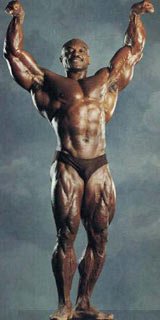
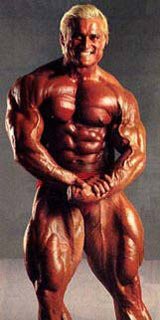
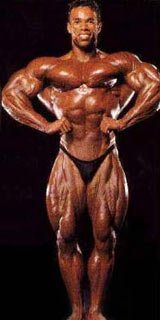
 Click Image To Enlarge.
Click Image To Enlarge. I Urge You To Look Up The Poundages Of Sergio Oliva,
Tom Platz, And Kevin Levrone's Shoulder Lifts.

What Constitutes Full Development?
Size is the main thing, because sizable deltoids make the waist smaller, emphasizes your V-taper and exudes an air of power to bystanders. Someone as broad as a barn door deserves some respect, whether you like it or not. But size can show weaknesses that are natural to the person. Overshadowing front delts are common because improper execution and too much weight on chest exercises usually puts all the strain squarely on the front deltoid, and since the shoulders absorb and love heavy weight, they will grow out of proportion. So usually this area doesn't need much extra work, and you'll try and avoid over-stimulating the front area in your compound exercise as well.
The side head is never an issue as long as the other two are in proportion to each other. There is no such thing as a side deltoid that is too big. The bigger they are, the wider and bigger you look. Lack of size can be an issue, but if your compound exercise puts the majority of the strain there and you keep working the laterals hard as well, this problem will correct itself. You will grow as your strength increases.
The rear head is the greatest problem. It's usually the smallest and takes a lot of work to bring it up to match the front head that gets a lot more work on any given day. So this will be priority A number 1. Only with full and complete development can you show off your physique for what it is worth.

Physiology Of The Muscle
The shoulders are actually three different muscles, working together to assure the good functioning of the arms. They lift and rotate the arms on the shoulder joint as the main function, and also assist the triceps (actually they carry more of the weight) in pressing weights overhead and the pectorals in pressing weight to the front of the body. So the strength and combinational working will come from the presses and the rotation work (not actual rotation but lateral movements as segments of rotation. Actual rotation with weight damages the rotator cuff) will be trained mostly with straight-arm lateral movements. That is the more isolative work.
The three heads of the shoulders will take care of the lateral range of motion in the three directions: the anterior or front head will allow the arm to be raised up to the front of the body. The side motion, the most isolated and strongest point, is the job of the medial or middle head.
And last but not least, the lateral or rear head will allow the arm to rotate backwards and has a strong relation with the lower trapezius. This is usually the weaker head for most people (all but the genetically blessed) because this is obviously the motion least practiced in daily life. But to bring out the full quality you'll need to get all heads both together and separately and to keep your size proportionate you'll need to prioritize the weaker head.

Training The Muscle
In my opinion only two compounding exercises fulfill the need for size of all three heads, namely the behind-the-neck press and the correct version of the dumbbell press. For beginners and beginning intermediates one of these exercises should be your opening exercise, and even for more advanced lifters if they still lack size in the area. I'm not a strong believer in behind-the-neck presses because of the extreme risk of rotator cuff injuries when you start handling heavy weights.
To counter this effect you should only lower the bar to the middle of the head just below the point where elbow are at the same level as the shoulders. To perform the exercise correctly, determine the placing of your hands on the bar. When elbows reach shoulder height your forearm should form a 90 degree angle atop your upper arm. That is the correct placement of the hands. Start with arms stretched over the head and lower the bar in a controlled manner to just below the 90 degree angle prescribed before and return to the starting point, focusing on contraction of all three heads.
The other exercise, my favorite, is the correct dumbbell press as the old-timers did it. I learned the correct way from studying the great Arnold Schwarzenegger. This exercise, because your head is not an obstacle, allows for deeper stretching ensuring more lower delt development. Start with a dumbbell in each hand. Elbow should be an inch or 5 below shoulder level and the dumbbells just above it. Hold the dumbbells in a false grip (thumb same side as other fingers) and bring up the dumbbells.
Now as you do this you should watch two things. The first is that you describe a wide motion, with the dumbbell farther away from you, at about the elbow level so that the forearms are always in a 90 degree angle with the floor and the second is that as soon as the elbows reach shoulder level that you tilt the weight inward so that the pinky is higher than the thumb at all time and the dumbbells form a V-shape at the point of contraction. Squeeze this point hard and focus on all three heads. Lower the dumbbells again, only leveling them with the floor after the elbows reach the shoulders.
I believe that this exercise is the best overall stimulus for the entire deltoid and it has been the center of my own workout for three years now. I include in all but my advanced programs for others as well and everyone seems amazed at the pump they feel once they learned the correct way to do this. I suggest you try it and I promise you will not be disappointed. For me this has been a revelation in terms of training shoulders.
Both exercises should be done with a straight back. If this is a problem I suggest standing against the wall or sitting in a chair or against an upright bench. Next we move to the side head for the first isolative work. You may choose to do rear deltoid work first, if this is a really weak point, but otherwise getting the side head first is best since there is no such thing as a shoulder that is too wide.
Next to stimulating immense thickness in all heads, you'll need to add to the width of the shoulder. The best exercise for this is the Side Lateral Raise or any variation thereof. I prefer and recommend the two-handed version for most beginning and intermediate athletes, but if you have the skill to stay strict on a single-handed alternate version, you will find that it allows for heavier weights. But beware of excessive cheating.
If you find you cheat too much still (Some people just can't help but swing forward before the lift) even in the 2-handed version, do this exercise seated against an upright bench (90 degrees). Start with the hands, holding dumbbells, at your side and not in front of you, as this encourages cheating. Lift with the arms bent ever so slightly along your body. The best indication of correct positioning is to see if your upper arms and the side of your body are in one line. However I find it more accurate to go by the feel for most.
Hold the dumbbells with the front end a little higher than the back end through most of the motion and when you squeeze in the point of contraction tilt it with the back end up as if pouring out a jug... Now lower slowly and bring back to your side. Do not swing back or lean forward as this will stress the lower back and take away from your physiological advantage. Other versions include the cable side lateral, 1-arm side lateral, seated side lateral, behind-the-back cable side lateral and the incline and decline 1-arm versions that stress the upper or lower delts. For beginners in level I its not necessary to add a third exercise, but for the level II beginners and intermediates, a third exercise (if you have no weak points to focus on) might be the decline side lateral to stress the upper portion or the incline side lateral (very hard, go light) for the lower delt.
So with that taken care of you'll need to get the front and rear heads still. The weakest is first up. In most cases that will be the rear head, but I don't know, there may be few people who have lagging front delts, but usually the front head gets plenty of work on chest day and will grow just fine even if you don't train it.
To get some stimulation in the rear head you can employ the rear lateral raise or a machine that simulates that effect. There are two ways of doing the rear lateral that are effective. Three if you count the variations, but lets stick to dumbbells for now. Grab a dumbbell in each hand and bend through your knees a bit. Now bend at the waist and let your arms hang straight down and keep back straight. This way allows for more cheating which isn't always a good thing.
The second way is to sit at the edge of a bench with your lower legs in a 90 degree angle or wider with the upper legs. Bend at the waist and let your upper body rest on your upper legs. Let your arms hang down, dumbbells meeting behind the lower legs. And the variation is when using a cable station. Bend through the knees slightly and bend over, so that the chest is in direct line with the cables. Attach two handles to a low pulley and cross them over (left pulley in right hand and vice versa) with arms straight down. The execution however is exactly the same.
With arms straight or almost straight and upper arms remaining at shoulder level raise the arms out to the side until the hands reach a point higher than the back. Then slowly lower. Take care to emphasize contraction since this isn't an exercise you can feel easily. When using a machine, make sure you put yourself in a position where the elbows can be pushed up and back and not down and back, because that will get more of the lower traps than the rear delts. That is the danger of machines though. These are the limitations of rear delt training, apart from hoping that you hit more of them on back day, there isn't much else you can do. Just this and lots of it.
One way a lot of the people did it in the old days, but this isn't easy, is the lying rear lateral. Lay on a flat bench but on your side. The arm on the bottom should be beneath the head. Hold a dumbbell in your free hand and hold it in front of you at arms length. Now raise the dumbbell keeping the arm straight over the body. Until almost perpendicular then lower slowly. Because you are holding the weight in front of you it can be difficult at times to secure the body properly. Stability isn't your strong point in this position.
That leaves the front head. Generally two exercises apply to get some isolation from the front head. They are barbell front raises and alternate front raises. To do the barbell front raise grab a barbell about shoulder width apart, in a knuckle-grip. Let it hang down and rest against the middle of your upper legs. Now raise it up with straight arms until over your head, hold for a count, then slowly lower the barbell again. That's it.
To do the alternate dumbbell front raise you grab two dumbbells and let them hang down against the front of the leg, as with the barbell. Now, keeping the arms straight, lift up one arm straight in front of you until just above the shoulder and then lower in a controlled fashion. As the first one nears the bottom, start raising up the other arm in the same way. Now keep alternating them in this fashion. The advantage here is that you can really isolate the front delt by tilting the dumbbell in when you reach the top of the motion, so that the pinky is higher than the thumb. This hits the muscle in the deepest of the core.
However in a phase where I need to really start showing the separation between the front delt and the chest, I try to get at it from the angle where I need it most and I do lying front raises. I grab a barbell and rest it against my legs, only this time I'm laying down on a flat bench and I raise my arms up to a point that is just short of perpendicular. If I go that high, I take the strain off. This exercise was taught to me by my friend John and really helped me to get that separation, that comes really hard to me, for my last contest.
That is the complete deltoid area, but sometimes even that is not enough. For most it comes natural and it definitely improves with size, but not everyone has great separation between the side delts and arms or the side delts and traps. For this we use incline and decline variations of the 1-arm side lateral. To get more definition in the lower delt to really separate the side head from the arms and create wonderful definition between the shoulder and brachialis you can do the incline 1-arm side lateral raise.
Lean against a wall with one shoulder and plant your feet about 1 to 2 feet away from the wall so you slope down. In the other hand hold a dumbbell that is resting against the side of the leg. Raise the dumbbell up as with a side lateral to a point that is just over parallel to the floor. So the arm doesn't make a full 90 degree motion. That is the end of the strain. This is a really hard exercise, so don't go too heavy. Cheating on this is hard without bending the body, so you have a fail-safe. Switch arms after every set.
If you need more definition between the traps and shoulders you need to target the top of the side deltoid. You do this and hit the lower end of the traps with upright rows, but those will be discussed in the article about trap training. To get it from the angle of the shoulder you do decline 1-arm lateral raises. You stand against a pole or an upright with your feet as close as possible. Now grab on to it with the hand on the same side. Extend your arms so you are hanging in an angle of approximately 50 degrees. Hold a dumbbell in the other hand and let it hang straight down. So in this instance it is not touching the leg. Again raise up the dumbbell as in a side lateral to a point that is parallel to the floor. Here we do have a 90 degree range of motion but the dumbbell finishes above the shoulder because you placed the point of strain higher by putting the body in an unnatural angle.

Other Exercises
The Military Press is a classic among the compound exercises. I feel it rather irrelevant because it is a compound exercise but only targets the front delts. However as a strength training component the military Press has lost none of its glory. If you seek magnificent lifting strength for shoulders and upper chest, the military press is one of the fastest methods of achieving that. To perform a correct military press, stand upright with hands farther than shoulder width apart. The exact width is a personal choice depending on the specific goal you hope to obtain. The wider, the more of the outside shoulder you get. The barbell is resting on your upper chest and the movement is simply lifting the barbell overhead to a lockout position, attempting to limit lower back movement.
Reverse side laterals are an exercise I first attempted after seeing a picture of Bertil Fox doing a total side laterals (combination of side lateral and reverse side lateral) and I found that they made the front delts burn like nothing else. To do them hold your arms up parallel to the floor as in the point of contraction of the side lateral and hold dumbbells in your hand. This time your palms are facing up and with slightly bent arms your bring the dumbbells together over your head. Almost as if doing flyes while standing up. The Total side lateral consists of doing a side lateral to point of contraction, twisting palms up and completing the reverse side lateral to point of contraction, then lowering in similar fashion. Quite a tough exercise and if you are shaping up your side and front delts for competition it's a definite must-try.

Going After Weak Points
It may seem like I'm really hammering the issue, but I assure it is necessary. That is not, however, why I brought it up again. This is a section I intend to add to every chapter on body-part training to illustrate what weaknesses can cause in showing your body to others, judges or onlookers. This will allow you to make a better selection from the exercises above and prioritize the areas that need the most work.
The front delt can have both the problem of being too big or too small. If it's too big it takes a while for the rest of the shoulder to catch up. The three heads are placed in a horseshoe on the end of the clavicle bone. Too large a front head gives an amateurish, bulkish impression and gives you a really exaggerated view in a rear double biceps pose that totally negates the size of the other heads. On the other hand a front delt that is too small in comparison, will, in the same pose, make it look as though your shoulders disappear.
You will not get any definition between the shoulder and chest in the front poses. This could still be a problem nonetheless, but it is a fact if your front head lacks in size. The side head is the center of width. It is the pinnacle of the V-taper and lack of size their seriously impairs overall size and width, making for a lackluster appearance. The rear head can be covered up in all front and overhead poses, but from the side and rear relaxed poses it gives you a hulking look, as if your back wasn't straight. That takes away from the back too.
A lack of overall size is the worst thing that can happen however. Not everyone is genetically blessed with a very thin waist, and the appearance of the slim center of the X-frame is dependent on that. Only wide shoulders can repair that and give you a seemingly much smaller waist. If not, not only does your waist look bigger, you just don't look as impressive. No radiation of power, no look of confidence. All poses rely to some extent on how your shoulders look, so they are well worth the work.

Progression Of Training
For an absolute beginner investing a lot of time in power work (4-6 sets with 1 or 2 exercises) you can get by with that and some isolation work for the side and rear heads. After that it is best to start investing more time in that, and once satisfied with the workload in that area your next addition should be some work for the front head, preferably isolative, because they already get much power work doing bench presses and incline bench presses. Since you always include some pressing motions in chest work, this is the last thing to add.
Work with your nutrition, and as soon as you feel you can recover fully from a workout, you can add more. For a beginner some 8-12 exercises is enough and an early intermediate putting his best foot forward should get a good 12 to 18 sets. In later stages you don't really need to add more, but if you can handle it, why not? 18 sets is usually plenty because that already allows you to 5 exercises with 3 or 4 sets per exercise and you don't need more. If you do add more work, add sets to your power exercises. This is the one muscle where compound exercises and lots of heavy strength work remains important even into the advanced stages.

